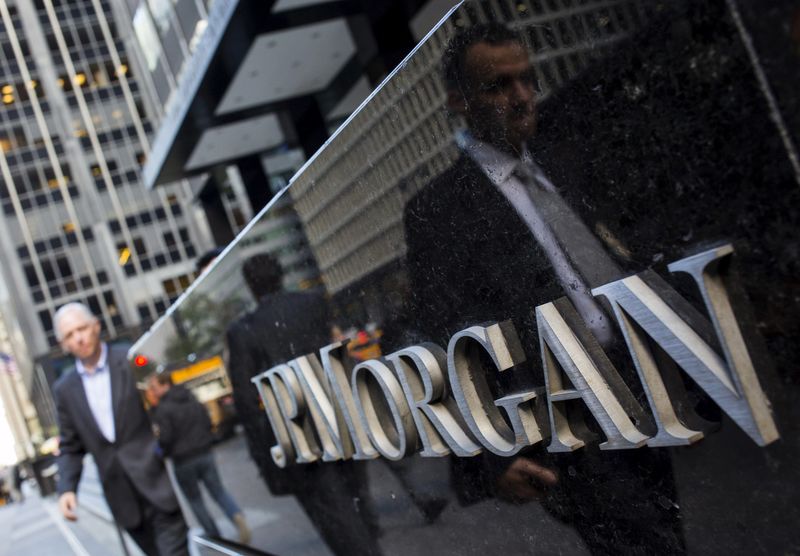Investing
US regulators propose ordering banks to hold 16% more capital

© Reuters. FILE PHOTO: The Empire State Building and Manhattan skyline are pictured from the Summit at One Vanderbilt observatory in Manhattan in New York City, U.S., April 14, 2023. REUTERS/Mike Segar/File Photo
By Pete Schroeder
WASHINGTON (Reuters) -U.S. regulators unveiled a sweeping overhaul Thursday that would direct banks to set aside billions more in capital to guard against risk, which was immediately slammed by the industry as “misguided”.
If fully implemented, the proposal would raise capital requirements for large banks by an aggregate 16% from current levels, with the brunt felt by the largest and most complex firms, regulators said. The industry is already warning that such a big hike could force them to trim services, raise fees, or both.
Agency officials argued Thursday that such costs would be more than offset by the benefit of a more resilient banking system.
The proposal, approved by the Federal Deposit Insurance Corporation and set to be voted on by the Federal Reserve, marks the first in an extensive effort to tighten bank oversight, particularly in the wake of spring turmoil that saw three large financial firms fail.
However, the effort was not unanimous. Two Republican members of the FDIC voted against the proposal as misguided and onerous, and two Republican members of the Fed indicated in prepared remarks they would also oppose the package on similar grounds.
Fed Chair Jerome Powell, a Republican who was renominated to the post by President Joe Biden, said in a prepared statement he supported advancing the proposal to receive public comment, but added regulators must strike a “difficult balance.”
“Congress and the American people rightly expect us to achieve an effective and efficient regulatory regime that keeps our financial system strong and protects our economy, while imposing no more burden than is necessary,” he said.
The proposed rule, which would implement a 2017 agreement which originated via the Basel Committee on Banking Supervision, aims to overhaul how banks gauge their riskiness, and in turn how much reserves they must keep as a cushion against losses.
Fed Vice Chair for Supervision Michael Barr said the proposal better aligns capital requirements with risk, ensuring a more stable financial system.
The proposal would overhaul how banks must measure risk from lending, trading activities and internal operations. In several cases, the plan would scrap a prior reliance on bank internal models to measure various types of risk, instead opting for a standardized approach, which regulators argue would produce more consistent and comparable results.
The proposal also reverses previous relief for banks with over $100 billion in assets, after several midsized firms failed in the spring. Under the plan, banks of that size would have to account for unrealized gains and losses on available-for-sale securities, as well as adhere to a stricter leverage requirement.
That change would be felt most acutely by banks with between $100 billion and $250 billion in assets, such as Citizens Financial (NYSE:) Group, Fifth Third, Huntington and Regions which enjoyed several relaxed rules under changes implemented in 2019.
The largest U.S. banks would see capital requirements go up 19% on average, banks $250 billion or more would go up an average of 10%, and banks $100 billion-$250 billion up an average of 5%, in line with prior expectations.
Shares of major banks were flat or higher, with JPMorgan and Bank of America (NYSE:) flat, Goldman Sachs (NYSE:) up 0.3%, Citi up 2% and Morgan Stanley (NYSE:) up 0.3%.
The Securities Industry and Financial Markets Association said a proposed operational risk capital charge would penalize firms’ fee-based wealth management and investment banking activities.
“Imposing a punitive capital charge on businesses that provide steady fee income is misguided,” said SIFMA president and CEO Kenneth E. Bentsen, Jr in a statement.
The sweeping proposal, which spans over 1000 pages and asks for input on dozens of topics, will kick off an intense lobbying battle by the banking industry as firms seek to soften, delay, or otherwise derail the effort. Regulators said they will take public input on the proposal until November 30, and aim to have the requirements fully phased in by July 1, 2028.
Top officials at banks like JPMorgan Chase (NYSE:), Bank of America, and Morgan Stanley have warned stricter rules could force them to pull back from services or increase fees. Analysts say it could take years of retained earnings to comply, pinching their ability to boost dividends or buy back shares.
Agency officials said Thursday most banks already have enough capital to meet the proposal, and firms that need to catch up would need at most two years of retained earnings to do so.
Separately, the Fed also unveiled several technical adjustments to the surcharge it assesses on large global banks. Fed staff said the changes, which generally make calculating the surcharge more granular, would result in an additional $13 billion in capital requirements for the eight largest banks.
Read the full article here

-

 Investing4 days ago
Investing4 days agoThis All-Access Pass to Learning Is Now $20 for Black Friday
-

 Passive Income4 days ago
Passive Income4 days agoHow to Create a Routine That Balances Rest and Business Success
-

 Side Hustles5 days ago
Side Hustles5 days agoApple Prepares a New AI-Powered Siri to Compete With ChatGPT
-

 Side Hustles2 days ago
Side Hustles2 days agoA Macy’s Employee Made Accounting Errors Worth $132 Million
-

 Side Hustles6 days ago
Side Hustles6 days agoMIT Gives Free Tuition For Families Earning $200,000 or Less
-

 Passive Income5 days ago
Passive Income5 days agoCustomers Want More Than Just a Product — Here’s How to Keep Up
-

 Side Hustles4 days ago
Side Hustles4 days agoGift the Power of Language Learning with This Limited-Time Price on Babbel
-

 Investing1 day ago
Investing1 day agoFactbox-How Trump can overhaul US financial regulators when he takes office By Reuters


















